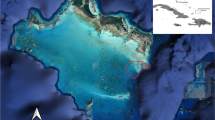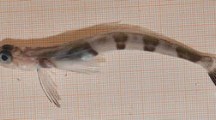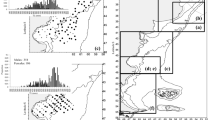Abstract
Analysis of the quantitative distribution and size composition indicated a high extent of the differentiation of the range of the blue shark Prionace glauca. This most abundant and widely distributed species in the oceanic epipelagial of the entire World Ocean remains for the first years of its life in coastal and neritic waters at depths of 80 m. At the earliest age, at a length under 70 cm, sexes separate into individual schools; females stay nearer to the coast. In the eastern Atlantic, two regions of juvenile habitats are recorded: to the north and to the south of the equator, with a typical gap between them in tropical waters. On reaching a length of 160–190 cm, sharks leave for oceanic waters; immature females follow dense aggregations of adult males situated in oceanic waters where their first mating takes place with a delayed fertilization until reaching sexual maturity. A similar pattern of distribution is traced in the eastern Pacific and other regions of the World Ocean. Under conditions of an increased demand and high prices of shark fins, such aggregations of juveniles and adult males where density exceeds average values dozens of times, can easily lead to overfishing and endanger the species existence and the stability of the structure of the oceanic biota as a whole. The necessity of introducing international protection measures with respect to such aggregations is substantiated.
Similar content being viewed by others

References
Anonymous. Report of the 2004 Inter-Sessional Meeting of the ICCAT Sub-committee on By-Catches: Shark Stock Assessment (Tokyo, Japan, 2004), SCRS/2004/014.Collect. Vol. Sci. Pap. ICCAT 57, 799–890. (2005).
C. L. Brenes, A. Hernandez, and J. Campos, “Distribucion espacial de capturas de tiburon en el Pacifico Nicaraguense y su relacion con algunas variables oceanograficas,” Rev. Biol. Trop. 48(2–3), 399–411 (2000).
J. G. Casey and N. E. Kohler, “Long Distance Movements of Atlantic Sharks from the NMFS Cooperative Shark Tagging Program,” Underwater Nat. 19, 87–91 (1991).
J. A. Castro and J. Mejuto, “Reproductive Parameters of Blue Shark, Prionace glauca, and Other Sharks in the Gulf of Guinea,” Mar. Freshwat. Res. 46(6), 967–973 (1995).
L. G. V. Compagno, FAO Species Catalogue, Vol. 4: Sharks of the World. An Annotated and Illustrated Catalogue of Shark Species Known to Date, Part 2: Carcharhiniformes, FAO Fish. Synop., No. 125, 251–655 (1984).
FIS. 2006. Market Reports. Tuna. January–March. www.fis.com
J. T. Harvey, “Food Habits, Seasonal Abundance, Size, and Sex of the Blue Shark, Prionace glauca, in Monterey Bay, California,” Calif. Fish Game 75(1), 33–45 (1989).
F. H. V. Hazin, A. A. Couto, K. Kihara, et al., “Distribution and Abundance of Pelagic Sharks in the South-Western Equatorial Atlantic,” J. Tokyo Univ. Fish. 77(1), 51–64 (1990).
R. Lessa, F. M. Santana, and F. H. Hazin, “Age and Growth of the Blue Shark Prionace glauca (Linnaeus, 1758) Off Northeastern Brazil,” Fish. Res. 66, 19–30 (2004).
F. F. Litvinov, “Structure of the Epipelagic Taxocenosis of Elasmobranshii in the Atlantic and Pacific Oceans and Its Changes in the Latest Geologic Time,” Vopr. Ikhtiol. 29(6), 973–984 (1989).
F. F. Litvinov, “The Use of Shark Teeth from Bottom Deposits for Dating Global Events in the History of the World Ocean,” in Proceedings of the 1st Congress of Russia’s Ichthyologists, Astrakhan, 1997 (1997), pp. 20–21.
F. F. Litvinov, “Sexual Dimorphism as an Index of the Isolation of West African Populations of the Cat Shark Scyliorhinus canicula,” Vopr. Ikhtiol. 43(1), 86–90 (2003) [J. Ichthyol. 43 (1), 81–85 (2003)].
F. F. Litvinov, “Changes of Taxocenoses of Elasmobranchii of the Open Ocean in the Post-Pleistocene,” in Modern Problems of Fish Systematics, in Proceedings of All-Russian Conference Dedicated to the 95th Anniversary of the Birth of A.N. Svetovidov and the 90th Anniversary of the Birth of D.N. Taliev (St. Petersburg, 1998).
F. F. Litvinov, “The Dense Male Aggregation over Submarine Mounts as an Integral Part of Species Range in the Blue Shark Prionace glauca,” ICES CM 2004/K:11 (2004).
F. F. Litvinov and V. V. Laptikhovsky, “Methods of Investigations of Shark Heterodonty and Dental Formulae’s Variability with the Blue Shark, Prionace glauca Taken as an Example,” ICES CM, No. 27 (2005).
R. M. Love, Probably More Than You Want to Know About the Fishes of the Pacific Coast (1991), Really Big Press, PO Box 60123, Santa Barbara, California, US 93160.
D. Macias and J. M. Serna, de la, “By-Catch Composition in the Spanish Mediterranean Longline Fishery,” in 4th Meeting of Europ. Elasmobranch Assos. Proc. (2002), p. 198.
R. Macnaughton, E. Rogan, V. Hernandez-Garcia, and C. Lordan, “The Importance of Cephalopods in the Diet of Blue Shark (Prionace glauca) South and West of Ireland,” ICES CM, 1998/M:7 (1998).
H. Matsunaga and H. Nakano, “Report on Information of By-Catch Fisheries Obtained from Observer Program for Japanese Tuna Longline Fisheries in the Atlantic Ocean,” Collect Vol. Sci. Pap. ICCAT 51(1), 1805–1811 (2000).
J. Mejuto and B. García-Cortés, “Reproductive and Distribution Parameters of the Blue Shark Prionace glauca, on the Basis of On-Board Observations at Sea in the Atlantic, Indian and Pacific Oceans,” SCRS/2004/103.Sci. Pap. ICCAT 58(3), 951–973 (2004).
A. A. Nesterov, “The Contribution of AtlantNIRO to the Study of Fish Resources in the Southeastern Part of the Pacific Ocean,” in All-Russian Scientific Conference on the Historic Experience of Scientific and Commercial Studies in Russia (VNIRO, Moscow, 2002), pp. 146–152.
V. V. Ovchinnikov, A. K. Sigaev, V. Z. Gaikov, et al., Methodical Justification of the Search, Fishery, and Biological Studies of Tunas, Swordfishes, and Sharks in the Atlantic Ocean (AtlantNIRO, Kaliningrad, 1985) [in Russian].
N. V. Parin, Ichthyofauna of the Oceanic Epipelagial (Nauka, Moscow, 1968) [in Russian].
N. V. Parin, Fishes of the Open Ocean (Nauka, Moscow, 1988) [in Russian].
N. V. Parin, A. N. Mironov, and K. N. Nesis, “Biology of the Nazca and Sala y Gomez Submarine Ridges, An Outpost of the Indo-West Pacific Fauna in the Eastern Pacific Ocean: Composition and Distribution of the Fauna, Its Communities and History,” Adv. Mar. Biol. 32, 145–242 (1997).
F. A. Patokina and F. F. Litvinov, “Food Composition and Distribution of Demersal Elasmobranches on Shelf and Upper Slope of North-West Africa,” ICES CM 2004/K:19 (2004).
H. L. Pratt, Jr., “Reproduction in the Blue Shark, Prionace glauca,” Fish. Bull., No. 77(2), 445–470 (1993).
H. L. Pratt, Jr., “The Storage of Spermatozoa in the Oviducal Glands of Western North Atlantic Sharks,” in The Reproduction and Development of Sharks, Skates, Rays and Ratfishes Environ. Biol. Fish. 38(1–3), 139–149 (1993).
D. E. Schindler, T. E. Essington, J. F. Kitchell, et al., “Sharks and Tunas: Fisheries Impacts on Predators with Contrasting Life Histories,” Ecol. Appl. 12(3), 735–748 (2002).
T. C. Sciarotta and D. R. Nelson, “Diel Behaviour of the Blue Shark, Prionace glauca, Near Santa Catalina Island, California,” Fish Bull. 75(3), 519–528 (1977).
O. Sosa-Nishizaki, E. Fulong-Estrada, J. A. Reyes-Gonzales, and J. C. Perez-Jimenez, “Blue Shark (Prionace glauca) Fishery in Baja California, Mexico: An Example of Artisanal and Middle Scale Fisheries Interaction,” Sci. Counc. Res. Doc. NAFO, No. 02/140 (2002).
J. D. Stevens, “Blue and Mako Sharks By-Catch in the Japanese Longline Fishery off South-Eastern Australia,” in Sharks: Biology and Fisheries, Aust. J. Mar. Freshwat. Res. 43(1), 227–236 (1992).
F. Uiblein, A. Geldmacher, F. Koester, et al., “Species Composition and Depth Distribution of Fish Species Collected in the Area of the Great Meteor Seamount, Eastern Central Atlantic, During Cruise M42/3 with Seventeen New Records,” Inf. Tec. Inst. Canar. Cienc. Mar., No. 5, 49–85 (1999).
Author information
Authors and Affiliations
Additional information
Original Russian Text © F.F. Litvinov, 2006, published in Voprosy Ikhtiologii, 2006, Vol. 46, No. 5, pp. 643–655.
Rights and permissions
About this article
Cite this article
Litvinov, F.F. On the role of dense aggregations of males and juveniles in the functional structure of the range of the blue shark Prionace glauca . J. Ichthyol. 46, 613–624 (2006). https://doi.org/10.1134/S0032945206080091
Received:
Issue Date:
DOI: https://doi.org/10.1134/S0032945206080091



